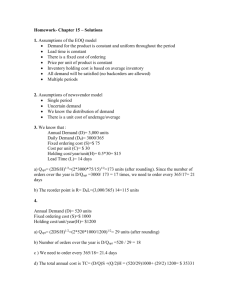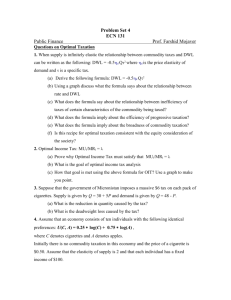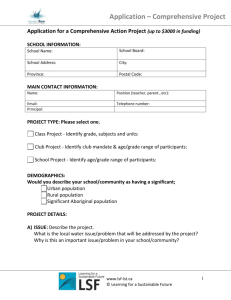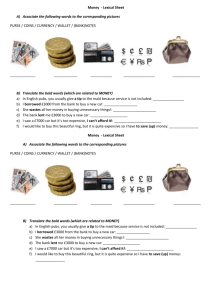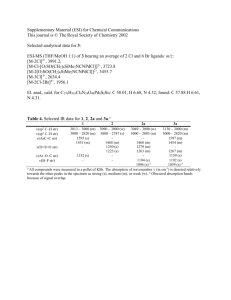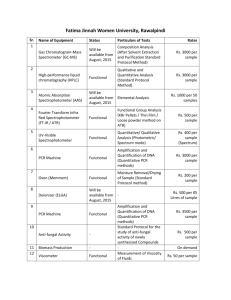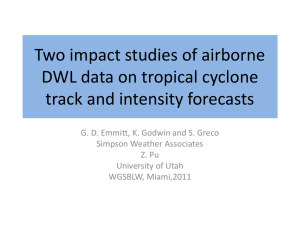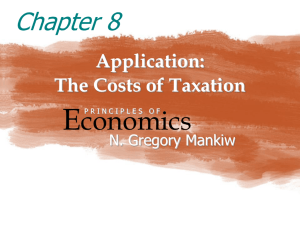Price Controls and Quotas
advertisement
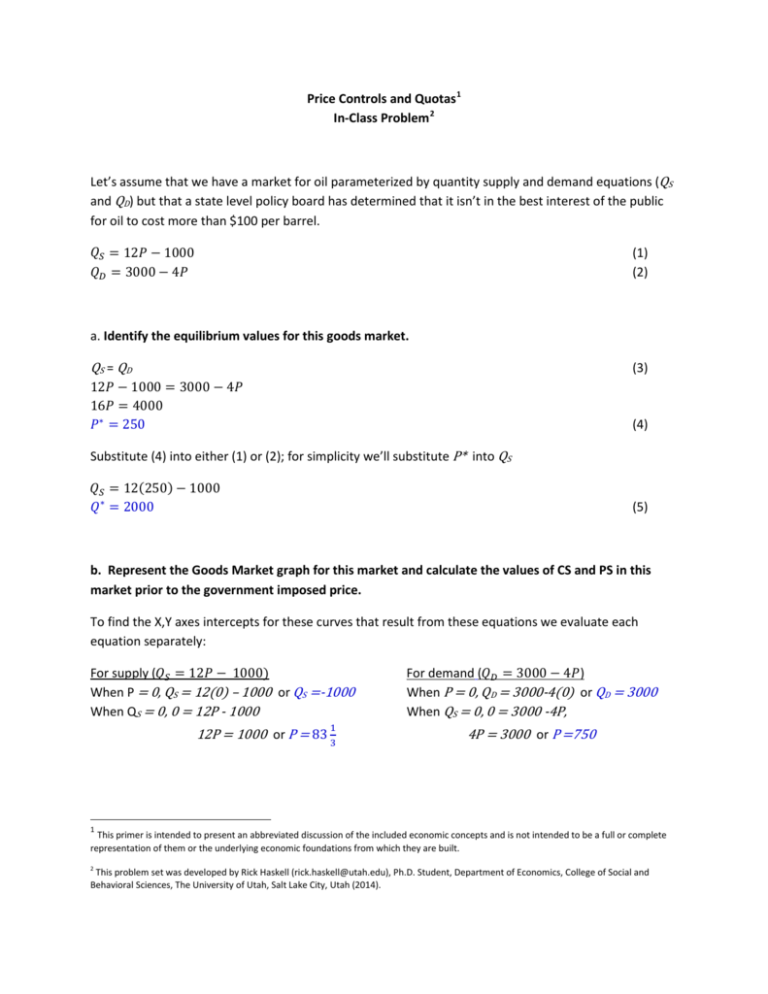
Price Controls and Quotas 1 In-Class Problem 2 Let’s assume that we have a market for oil parameterized by quantity supply and demand equations (QS and QD) but that a state level policy board has determined that it isn’t in the best interest of the public for oil to cost more than $100 per barrel. (1) (2) 𝑄𝑆 = 12𝑃 − 1000 𝑄𝐷 = 3000 − 4𝑃 a. Identify the equilibrium values for this goods market. QS = QD (3) 12𝑃 − 1000 = 3000 − 4𝑃 16𝑃 = 4000 𝑃∗ = 250 (4) 𝑄𝑆 = 12(250) − 1000 𝑄 ∗ = 2000 (5) Substitute (4) into either (1) or (2); for simplicity we’ll substitute P* into QS b. Represent the Goods Market graph for this market and calculate the values of CS and PS in this market prior to the government imposed price. To find the X,Y axes intercepts for these curves that result from these equations we evaluate each equation separately: For supply (𝑄𝑆 = 12𝑃 − 1000) When P = 0, QS = 12(0) – 1000 or QS =-1000 When QS = 0, 0 = 12P - 1000 1 12P = 1000 or P = 83 3 For demand (𝑄𝐷 = 3000 − 4𝑃) When P = 0, QD = 3000-4(0) or QD = 3000 When QS = 0, 0 = 3000 -4P, 4P = 3000 or P =750 1 This primer is intended to present an abbreviated discussion of the included economic concepts and is not intended to be a full or complete representation of them or the underlying economic foundations from which they are built. 2 This problem set was developed by Rick Haskell (rick.haskell@utah.edu), Ph.D. Student, Department of Economics, College of Social and Behavioral Sciences, The University of Utah, Salt Lake City, Utah (2014). Which yields a graphic model that looks something like this: Price Goods Market Model Barrels of Oil 750 CS P* = 250 83 1/3 -1000 𝐶𝑆 = 𝑃𝑆 = (2000)(750−250) 2 1 (2000)�250−83 � 3 DWL = 0 2 QS PS QD 0 3000 Q* = 2000 Quantity (6) = 500,000 (7) = 166,670 c. Is the exogenously determined price a price floor or a price ceiling? Since the determined price is $100, which is less than P* = 250, it is a price ceiling. d. Represent the goods market graph for this market with the government imposed price and calculate the values of CS , PS and DWL resulting from this price distortion. 𝑄𝑆 = 12(100) − 1000 = 200 = 𝑄 𝑆 𝑄𝐷 = 3000 − 4(100) = 2600 = 𝑄 200 = 12(𝑃′ ) − 1000; P’ = 100 𝐷 Price (9) (10) Goods Market Model Barrels of Oil 750 700 CS QS DWL P* = 250 PC = 100 83 1/3 0 QD PS (8) QS=200 D Q* = 2000 Q =2600 3000 Quantity With these values in mind we can now calculate the areas of CS , PS and DWL 𝐶𝑆 = 𝑃𝑆 = (200)(750−700) 2 1 3 (200)�100−83 � 𝐷𝑊𝐿 = (12) = 1,667 2 (2000−200)(700−100) 2 (11) + (700 − 100)(200) = 125,000 (13) = 540,000 In this case, where PC = $100, we see that the oil market is no longer in equilibrium. It’s been forced out of equilibrium by some form of friction (the exogenously imposed P ) and we see that QS < QD which would represent a shortage of oil at a $100 per barrel price, which might motivate some form of black market activity. Now, let’s suppose that instead of imposing a price distortion in this market, the government imposed a quota such that oil production and importation could not exceed 1,500 barrels and the government fixed the price of oil at $250. What effect would this have on the market, including changes in CS, PS and DWL? The graphic model will now look like this: Price 𝑄𝑆𝑄 750 Goods Market Model Barrels of Oil CS D P = 375 P* = 250 PS = 208 1/3 83 1/3 QS DWL PS 0 QD QQ=1500 Q* = 2000 3000 Quantity We’ll need the following additional values of P to determine the CS, PS and DWL values and to consider what this is really doing to this market: 𝑄𝑆 : 1500 = 12𝑃 𝑆 − 1000; 𝑃 𝑆 = 375 𝑄𝐷 : 1500 = 3000 − 4𝑃𝐷 ; 𝑃𝐷 = 1 208 3 (14) (15) And then we can plug these values into our methods for finding CS , PS and DWL 𝐶𝑆 = (1500)(750−375) 2 + (375 − 250)(1500) = 281250 + 187500 = 468,750 1 3 𝑃𝑆 = (1500) �250 − 208 � + 𝐷𝑊𝐿 = 1 (2000−1500)�375−208 � 3 2 1 3 1 3 (1500)�208 −83 � 2 = 41,667.5 = 62505 + 93750 = 156,255 (18) (19) (20) With this imposed quota and price, we have to concern ourselves with the this has effected both consumers and producers. Consumers are paying a price ($250) well below what that might have been willing to pay based on their demand relation. Conversely, producers are going to get a price above that which they would have expected for the quantity to be supplied. So on the surface of this, it looks good for both the producers and consumers. However, we have to consider the existence of DWL and what this means. There is roughly 500 barrels of oil that are neither producer nor consumed. What is the lost utility to the consumer? What are the lost profits for the producers? And then we have to also consider what is the rationale the policy makers used in setting this particular policy.

